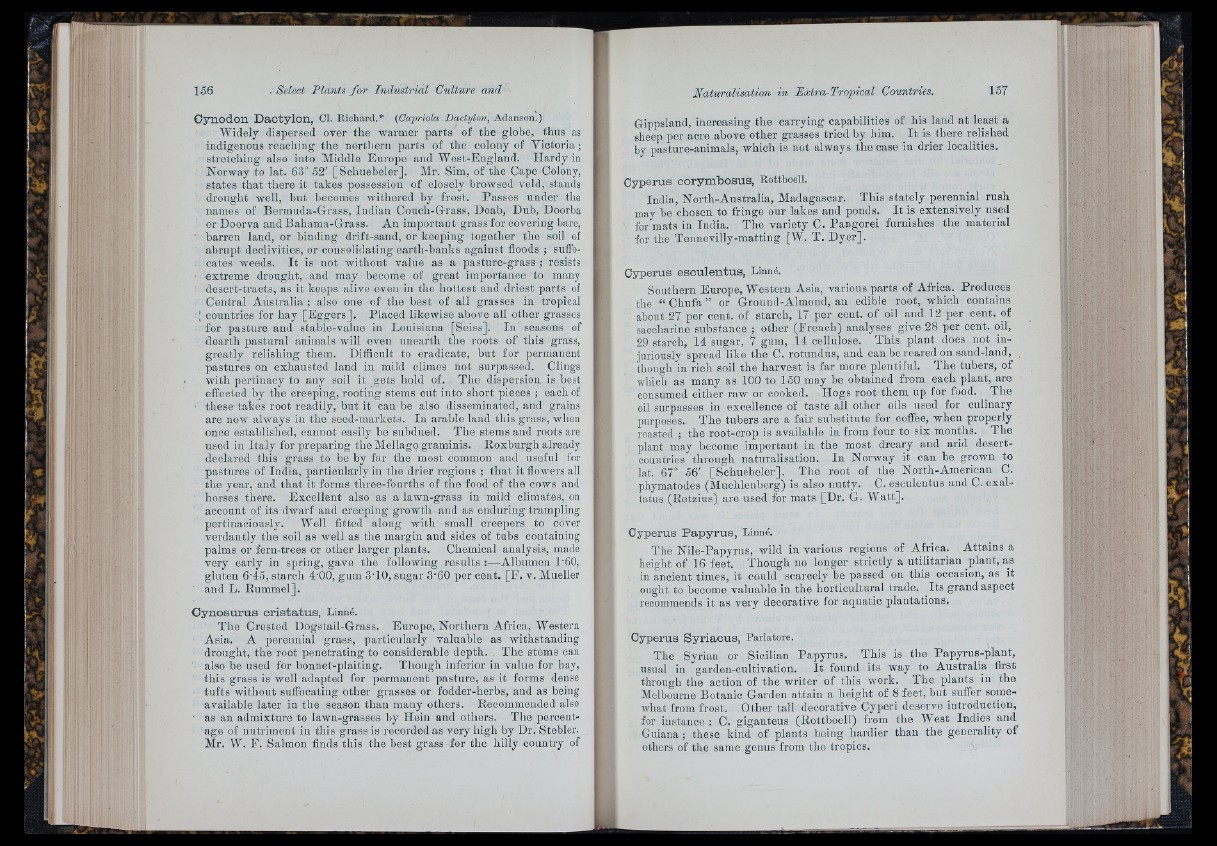
^ fr
li
C y n o d o n D a c ty lo n , Cl. Richard.* (Gapi-iola Dactylm, Adanson.)
Widely dispersed over the warmer parts of the globe, thus as
indigenous reaching the northern parts of the colony of Victoria ;
stretching also into Middle Europe and West-England. Hardy in
Norway to lat. 63° 52' [Schuebeler]. Mr. Sim, of the Cape Colony,
states that there it takes possession of closely browsed veld, stands
drought well, but becomes withered by frost. Passes under the
names of Bermnda-Grass, Indian Couch-Grass, Doab, Dub, Doorha
or Doorva and Bahama-Grass. An important grass for covering bare,
barren land, or binding drift-sand, or keeping together the soil of
abrupt declivities, or consolidating eartli-banks against floods ; suffocates
weeds. I t is not without value as a pasture-grass ; resists
extreme drought, and may become of great importance to many
desert-tracts, as it keeps alive even in the hottest and driest parts of
Central Australia ; also one of the best of all grasses in tropical
; countries for hay [Eggers]. Placed likewise above all other grasses
for pasture and stable-value in Louisiana [Seiss]. In seasons of
dearth pastural animals will even unearth the roots of this grass,
greatly relishing them. Difficult to eradicate, but for permanent
pastures on exhausted laud in mild climes not surpassed. Clings
with pertinacy to any soil it gets liold of. The dispersion is best
effected by the creeping, rooting stems cut into short pieces ; each of
these takes root readily, but it can be also disseminated, and grains
are now always in the seed-markets. In arable land this grass, when
once established, cannot easily be subdued. 'The stems and roots are
used in Ita ly for preparing the Mellago graminis. Roxburgh already
declared this grass to be by far the most common and useful for
pastures of India, particularly in the drier regions ; th a t it flowers all
the year, and th a t it forms three-fourths of the food of the cows aud
horses there. Excellent also as a lawn-grass in mild climates, on
account of its dwarf aud creeping growth aud as enduring trampling
pertinaciously. Well fitted along with small creepers to cover
verdantly the soil as well as the margin and sides of tubs containing
palms or fern-trees or other larger plants. Chemical analysis, made
very early in spring, gave the following results :—Albumen 1'60,
gluten 6-45, starch 4'00, gum 3T0, sugar 3'60 per cent. [F . v. Mueller
and L. Rummel].
C sm o su ru s c r is ta tu s , Linné.
The Crested Dogstail-Grass. Europe, Northern Africa, Western
Asia. A perennial grass, partioularly valuable as witlistaudiug
drought, the root penetrating to considerable depth. 'The stems can
also be used for bonnet-plaiting. Though inferior in value for hay,
th is grass is well adapted for permanent pasture, as it forms dense
tufts without suffocating other grasses or fodder-herbs, and as being
available later in the season than many others. Reoommended also
as an admixture to lawn-grasses by Hein and others. 'I'he percentage
of nutriment in this grass is recorded as very high by Dr. Stebler.
Mr. W. F. Salmon finds this the best grass for the hilly country of
Gippslfind, increasing the carrying capabilities of his land a t least a
sheep per acre above other grasses tried by him. I t is there relished
by pasture-animals, which is not always the case in drier localities.
C yperus c o rym b o su s , Rottboell.
India, North-Australia, Madagascar. This stately perennial rush
may be chosen to fringe our lakes and ponds. I t is extensively used
for mats in India. The variety C. Pangorei furnishes the material
for tho Tennevilly-matting [W. T. Dyer],
Cyperus e s c u le n tu s , Linné.
Southern Europe, Western Asia, various parts of Africa. Produces
the “ Cliufa ” or Ground-Almond, an edible root, which contains
abont 27 per cent, of starch, 17 per cent, of oil and 12 per cent, of
saccharine substance ; other (French) analyses give 28 per cent, oil,
29 starch, 14 sugar, 7 gum, 14 cellulose. This plant does not injuriously
spread like the C. rotnndus, and can be reared on sand-land,
tliongh in rich soil the harvest is far more plentiful. The tubers, of
which as many as 100 to 150 may be obtained from each plant, are
consumed either raw or cooked. Hogs root them up for food. ^ The
oil surpasses in excellence of taste all other oils used for culinary
purposes. 'The tubers are a fair substitute for coffee, when properly
roasted ; the root-crop is available in from four to six months. 'The
plant may become important in the most dreary and arid desert-
countries through naturalisation. In Norway it can he grown to
lat, 67° 56' [Schnebeler]. 'The root of the North-American C.
phymatodes (Muehlenberg) is also nutty. C. esculentus and C. exaltatus
(Retzius) are used for mats [Dr. G. Watt],
Cy p eru s P a p y ru s , Linné.
The Nile-Papyrus, wild in various regions of Africa. Attains a
height of 16 feet. 'Though no longer strictly a utilitarian plant, as
iu ancient times, it could scarcely be passed on this occasion, as it
ought to become valuable in the horticultural trade. Its grand aspect
recommends it as very decorative for aquatic plantations.
Cyperus S y ria c u s , Parlatore.
The Syrian or Sicilian Papyrus. This is the Papyrus-plant,
usual in garden-cultivation. I t found its way to Australia first
through the action of the writer of this work. The plants in the
Melbourne Botanic Garden attain a height of 8 feet, but suffer somewhat
from frost. Other tall decorative Cyperi deserve introduction,
for instance : C. giganteus (Rottboell) from the IV est Indies and
Guiana ; these kind of plants being hardier than the generality of
others of the same genus from the tropics.